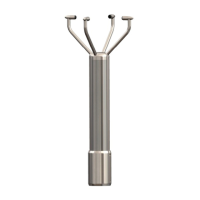Gill Instruments Ltd
_____________________________________________________________________________________________________________
________________________________________________________________________________________________
WindObserver 65 Page 29 Issue 4
Doc. No. 1390-PS-0039 June 2016
7. MESSAGE FORMATS & OPTIONS
On first applying power to the WindObserver 65, it will be in ‘Measurement Mode’, and it
will output wind measurement information within 3 seconds in one of the formats as
described below.
Setting the output format, units, other parameters, options and the communication settings
are all carried out in the alternative ‘Configuration Mode’.
See Section 8 CONFIGURING for details of how this is done.
The factory default settings are shown here in bold, and for convenience some
‘Configuration codes’ (as used to set the configuration) are shown in blue boxes.
For example M3.
7.1. Wind Speed format
The wind speed measurements can be output in one of the following formats:
UV, Polar, Customer formats (NMEA and Tunnel).
7.2. Output formats
The UV and Polar wind speed parameters are output in either ASCII or binary.
These parameters can be transmitted continuously or polled from the user.
Polar is also available in continuous NMEA format.
Output Formats Table
M14
Notes:-
1. Continuous Output: In this mode the unit continuously outputs a burst of RS422 level
data (the frequency determined by the output rate setting). After the burst of data and
until the next data burst the data lines revert to a high impedance state.
2. Polled Output: In this mode the data lines are in a high impedance state until the unit is
polled for data. Upon receipt of a poll command the unit outputs a burst of data at
RS485 levels and then reverts to a high impedance state until the next poll command
receipt.
Low wind speeds
Whilst the wind speed is below 0.05 metres/sec, the wind direction will not be calculated,
and the last known good direction figure is shown. All other output parameters will
continue to update at the output rate.

